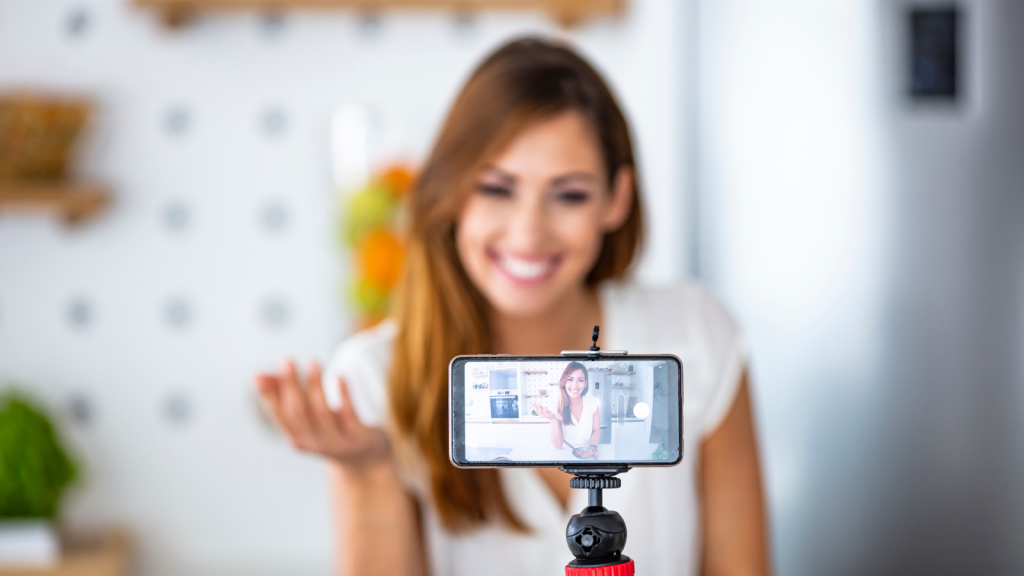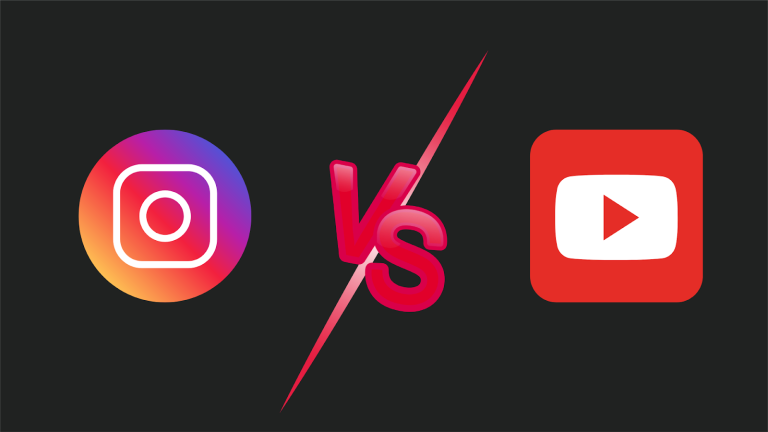You’ve got amazing content, but which platform should you focus on to make sure it reaches the right audience, Instagram or YouTube? It’s a common challenge for creators and businesses alike.
Instagram gives you the ability to quickly grab attention with eye-catching visuals, perfect for fast-paced engagement, while YouTube allows you to look deeper, offering both long-form and short-form content that helps build stronger connections with your audience over time. So, how do you know which platform is worth your time and effort?
In this blog, we’ll compare Instagram vs YouTube, taking a look at what each one brings to the table, so you can make an informed choice and start seeing results sooner.
Instagram vs YouTube for Influencers

Choosing between Instagram vs YouTube as an influencer can feel like a tough call because both offer unique perks. While Instagram is perfect for quick, eye-catching content, YouTube lets you dig deep and build long-lasting connections. Let’s break down how each platform can help you shine in different ways!
Instagram for Influencers
If you’re all about quick connections and instant feedback, Instagram’s quick-fire approach might be exactly what you need.
- Fast Engagement: Ideal for generating quick interactions through short-form, visually engaging content.
- Audience: Primarily attracts an impulse-driven audience seeking quick, digestible content.
- Content Types: Stories and Reels are the key features that drive visibility and engagement.
- Effectiveness: Great for B2C brands in industries like fashion, beauty, food, and travel, where immediate visibility leads to instant conversions.
- Conversion Focus: The platform’s rapid engagement facilitates instant conversions, making it suitable for time-sensitive promotions.
YouTube for Influencers
For influencers looking to build deeper connections with their audience and create long-lasting content, YouTube offers the space to do just that.
- Long-Form Content: YouTube excels at building deeper connections with audiences through comprehensive, educational content.
- Audience: Attracts a high-intent audience willing to invest time consuming in-depth videos.
- Content Types: Ideal for creating tutorials, how-to videos, and long-form discussions.
- Effectiveness: Particularly valuable for B2B marketing and promoting high-value products in sectors like technology, education, and finance.
- Conversion Focus: YouTube helps establish authority and offers stronger conversion rates due to the in-depth nature of the content.
Having explored how Instagram and YouTube support influencer strategies, it’s clear that behind-the-scenes management is key to success.
This is where Exly comes in, offering an all-in-one platform to streamline pricing, client relationships, and marketing, helping you grow your business effortlessly.
Instagram vs YouTube for Monetization

When it comes to making money from your content, Instagram and YouTube offer different paths to monetization. Whether you’re looking for quick brand deals or building a steady income stream, each platform brings its own set of opportunities. Let’s explore how each one stacks up in terms of earnings!
Instagram Monetization for Influencers
If you’re after fast deals and sponsorships, Instagram could be the better platform with plenty of chances to monetize your content quickly.
- Micro-Influencers: Influencers with 10,000 to 100,000 followers typically earn ₹5,000 to ₹50,000 per sponsored post.
- Top-Tier Influencers: Influencers with large followings can earn in the lakhs per post.
- Compensation Focus: Earnings are primarily based on consistent posting and audience engagement rather than content complexity.
- Monetization Method: Mainly through sponsored posts and brand collaborations, with additional opportunities through affiliate marketing.
YouTube Monetization for Influencers
For those wanting to build a steady stream of income, YouTube’s ad revenue and sponsorship options might offer a more reliable path to earning.
- Sponsored Videos: Creators can earn ₹50,000 to ₹5 lakhs per sponsored video depending on their audience and content niche.
- AdSense Revenue: Passive income generated through AdSense based on video views and ad clicks.
- Diversified Income: YouTube offers both active income (from sponsors) and passive income (from ad revenue sharing).
- Long-Term Financial Stability: Creators with consistent, engaging videos can build long-term financial growth through multiple revenue streams.
After seeing how each platform handles monetization for influencers, it’s time to look at how businesses can make the most of Instagram and YouTube.
Instagram vs YouTube for Businesses
For businesses looking to grow their brand, Instagram and YouTube each offer unique advantages. Whether you’re aiming for instant visibility or building long-term trust, these platforms provide different ways to connect with your audience. Here’s a look into how each platform can help your business grow!
YouTube for Businesses
If your business thrives on quick engagement and visual appeal, Instagram can help you reach people fast with striking images and videos.
- Brand Awareness & Discovery: Ideal for businesses focused on building long-term brand authority and educating their audience. YouTube’s SEO and shareable content significantly increase discoverability.
- Content Strategy: Best for educational content, product demos, and customer success stories. Effective for businesses in technology, education, and B2B services that need to provide detailed explanations.
- Customer Engagement: Focuses on long-term relationships where customers subscribe, comment, and share content. Engagement grows after trust is established through in-depth content.
- Monetization: Businesses can monetize through ads, sponsored content, and affiliate marketing, making it a strong platform for consistent ad-based revenue.
Instagram for Businesses
For businesses wanting to dive deeper into educational content or product demos, YouTube can be the right place to build a more engaged and trusting audience.
- Brand Awareness & Discovery: Great for quick visibility and immediate interaction with a discovery-driven audience. Perfect for generating instant brand awareness with highly visual content.
- Content Strategy: Best for lifestyle content, promotions, and visual storytelling. Ideal for B2C brands in fashion, beauty, food, and travel, where aesthetic visuals and quick messaging drive engagement.
- Customer Engagement: Provides instant engagement via Stories, Reels, and comments, allowing businesses to connect with followers in real-time for direct interaction and immediate responses.
- Monetization: Primarily through sponsored content and affiliate marketing. Instagram’s shopping features allow businesses to sell directly on the platform, making it ideal for e-commerce and direct sales.
After comparing how businesses use Instagram and YouTube, let’s take a look at how advertising works on both platforms and which one might be better for your brand.
Instagram vs YouTube for Advertising
When it comes to advertising, Instagram and YouTube offer distinct approaches to reaching your audience. From visually immersive ads to in-depth video content, each platform has its own way of capturing attention. Let’s take a look at how they stack up for advertisers!
| Platform | Ad Format | Description |
| Photo/Image Ads | Simple, cost-effective ads using single images in users’ feeds. Great for visually appealing content. | |
| Carousel Ads | Allows multiple images or videos in one ad. Perfect for storytelling or showcasing multiple products. | |
| Story Ads | Full-screen immersive ads appearing between organic Stories content. Effective for reaching a large daily audience. | |
| Interactive Ads | Includes polls, quizzes, and sliders to boost engagement and create viral content. Encourages active participation. | |
| YouTube | Skippable In-Stream Ads | Appear before, during, or after videos. Can be skipped after 5 seconds, requiring immediate attention to avoid skipping. |
| Non-Skippable In-Stream Ads | Must be watched in full (6-15 seconds). Guarantees full message delivery but may feel intrusive. | |
| Bumper Ads | Short (6 seconds or less) non-skippable ads. Great for quick brand messages and reinforcing awareness. | |
| Pricing Considerations | Operates on a CPM (cost per thousand impressions) model. Non-skippable ads tend to cost more per view, making sure of complete message delivery. |
After discussing advertising on YouTube and Instagram, let’s take a closer look at how short-form video content, like YouTube Shorts and Instagram Reels, stacks up on each platform.
YouTube Shorts vs Instagram Reels
YouTube Shorts and Instagram Reels both let you create quick, engaging content, but they each have their own vibe and audience. Let’s look into how these short-form videos compare when it comes to reach, engagement, and monetization!
- Platform Architecture and Core Functionalities
- YouTube Shorts: YouTube Shorts allows vertical videos of up to 60 seconds and benefits from Google’s search index, making it discoverable through both YouTube’s algorithm and external searches. This creates a dual pathway for content discovery.
- Instagram Reels: Reels supports 90-second vertical videos within Instagram’s ecosystem. Its discoverability depends on Instagram’s internal recommendation system and hashtag usage, with limited Google indexation for some content.
- Algorithmic Distribution Mechanisms
- YouTube Shorts: The platform uses a “explore and exploit” algorithm to test content with targeted audiences and expands reach based on engagement. It prioritizes retention rates, pushing videos with strong viewer retention.
- Instagram Reels: Instagram’s algorithm prioritizes content from users’ active followers and integrates Explore page suggestions. It focuses on shares and saves to boost content reach organically.
- Monetization Landscapes and Earning Potential
- YouTube Shorts: Monetization is available through YouTube’s Partner Program, requiring 500 subscribers and 3,000 valid views. Creators earn through ad revenue and additional streams like Super Chats and product placements.
- Instagram Reels: Instagram creators can monetize via brand sponsorships, virtual gifts during live sessions, and shopping integrations. Top influencers earn through direct sales, like merchandise and digital products.
- Engagement Dynamics and Audience Behavior
- YouTube Shorts: Shorts have long-term performance, with an average of over 70B daily views. Videos stay discoverable for 6-12 months, leading to consistent engagement.
- Instagram Reels: Reels generate quick engagement, with the average user spending 38 minutes per day viewing . Content needs frequent updates as relevance drops after 72 hours, making it key to post consistently.
- Interactive Features and Community Building
- YouTube Shorts: Shorts provide detailed audience analytics, helping creators refine content strategies. The focus is more on performance tracking than interactive features.
- Instagram Reels: Reels supports high interaction through polls, quizzes, and collaborative videos, with AR filters increasing profile visits. This fosters strong community building with high engagement rates.
Instagram vs YouTube: Industry-Specific Platform Analysis
When it comes to choosing the right platform for your industry, both YouTube and Instagram offer distinct advantages. Let’s break down how each platform works best for different sectors, from fitness to digital marketing, and help you decide where to focus your efforts.
| Industry | YouTube | |
| Fitness & Yoga Trainers | Quick workouts, daily motivation, transformation content | Long-form routines, detailed education, full practices |
| Finance & Stock Traders | Quick market updates, snapshot analyses | In-depth analysis, stock breakdowns, educational content |
| Astrology & Tarot Readers | Zodiac graphics, daily horoscopes, celestial events | Long-format readings, educational content, birth chart analyses |
| Business Consultants | Client testimonials, behind-the-scenes, tips | Educational content, case studies, B2B marketing |
| Dance Instructors | Choreography snippets, technique demos | Full choreography tutorials, performances, educational content |
| Digital Marketers | Showcase expertise, trends, platform updates | In-depth strategy, tool tutorials, B2B marketing |
After looking at how each platform fits different industries, the next step is to figure out which one works best for you based on your goals and content style.
Instagram vs Youtube: Which Platform Should You Choose?
Deciding between Instagram and YouTube can be tricky, but the right choice depends on your goals and content style. Let’s weigh the key factors to help you pick the platform that best aligns with your audience and business needs.
- Content Complexity:
- YouTube: If your content needs a bit more time to explain or demonstrate something, YouTube’s your go-to. It’s perfect for deep dives, tutorials, or educational videos that require more detail.
- Instagram: Short, sharp, and snappy? Instagram is made for that. If you can communicate your message in under 90 seconds, Instagram’s Stories or Reels will get your point across quickly and effectively.
- Audience Intent:
- YouTube: YouTube is where people come to learn, solve problems, and get deeper insights. It’s great for building trust with a high-intent audience who are looking for solutions, making it ideal for educational content or products that need a bit of convincing.
- Instagram: Instagram users are more about discovering and exploring. If you’re aiming for quick interactions, visibility, and brand awareness, Instagram’s the perfect place to engage users who might not yet know they need your product or service.
- Monetization Focus:
- Instagram: Looking for fast sales and sponsored deals? Instagram’s audience tends to convert quickly with impulsive purchases. If your revenue model relies on direct sales or sponsored content, Instagram gives you that instant boost.
- YouTube: Want to build a steady stream of income? YouTube is your best bet with its ad revenue, memberships, and long-form content monetization. It’s great for subscription-based services, courses, and creators looking for long-term revenue through engaging content that keeps people coming back.
Once you’ve decided which platform aligns with your goals, you might be wondering how to make the most of your content across both. Here’s how you can turn Instagram Reels into YouTube content!
How to Turn Instagram Reels into YouTube Content?
Got some killer Instagram Reels? Why not repurpose them for YouTube and reach a wider audience? Here’s how you can turn your short, snappy Reels into engaging YouTube content that keeps viewers coming back for more.
- Short-Form to Short-Form:
Upload Instagram Reels (up to 90 seconds) directly to YouTube Shorts. Resize to 1080×1920 pixels, add context-driven captions, and optimize with search-friendly keywords (e.g., #SEO, #Marketing).
- Compiling Reels into Long-Form YouTube Videos:
Combine 3-5 related Reels into a cohesive YouTube tutorial or vlog. Use transitions and voiceovers to connect the segments.
- Carousel Posts to Step-by-Step Guides:
Expand Instagram carousel slides into detailed blog tutorials. For instance, turn “7 Budget-Friendly Marketing Hacks” into a step-by-step guide with detailed explanations.
- Q&A Sessions to Podcast Series:
Repurpose weekly Instagram Live Q&As into podcast episodes like “Ask Me Anything Tuesdays.”
- User-Generated Content (UGC) Features:
Repost client testimonials from Instagram Stories into success stories in newsletters, adding personal touches and linking to the original Instagram post.
- Bite-Sized Teases for Multiple Channels:
Extract 15-30 second clips from Reels or Lives for YouTube Shorts, podcast teasers, and blog headers, with CTAs prompting users to visit the full content on other platforms.
Conclusion
Choosing between Instagram vs YouTube ultimately comes down to how you want to connect with your audience and what kind of content you’re creating. Whether you’re after fast engagement or long-term relationship-building, the key is consistency and finding what resonates with your audience. The right platform isn’t just about numbers, it’s about creating meaningful connections and delivering content that matters.
Whether you’re a fitness trainer, finance coach, astrologer, business consultant, dance instructor, or digital marketer, Exly helps you manage your Instagram and YouTube presence in one place. With Exly, you can:
- Showcase Your Socials: Add your Instagram and YouTube handles to your personalized Exly webpage, making it easy for your audience to discover all your content from one link.
- Centralize Your Brand: Display your workshops, courses, and digital products in one place, driving traffic from Instagram and YouTube for bookings and sales.
- Automate & Grow: Manage inquiries, payments, and communication via Exly’s dashboard, saving time to focus on content creation.
- Track & Promote: Analyze your audience, run promotions, and convert followers into clients with Exly’s marketing tools.
Want to turn your followers into customers? With Exly, you can create your own webpage and manage your entire business in one spot. Get started for free!
FAQs About Instagram vs YouTube
1. What happened to IGTV?
IGTV was discontinued in 2021, with longer videos now appearing directly in the Instagram feed.
2. Which platform should I focus on for video marketing?
If you’re creating long-form educational content, YouTube is the better choice. For quick engagement and brand promotions, Instagram works better.
3. Can you use the same content on both Instagram and YouTube?
Yes, you can repurpose content across both platforms, but make sure it’s optimized for each, shorter, snappier videos for Instagram and longer, more detailed videos for YouTube.
4. Does YouTube or Instagram have better video analytics?
YouTube offers more detailed video analytics, including audience demographics and watch time, helping you refine your content strategy over time.
5. Which platform instagram vs youtube is better for organic reach?
Instagram often offers quicker organic reach due to its algorithm prioritizing fresh content, while YouTube’s reach builds more gradually with SEO and consistent content.
6. Can you monetize content on Instagram without sponsorships?
Yes, through Instagram’s Shopping feature, affiliate links, and collaborations, influencers can monetize without relying solely on sponsorships.
7. Which platform is better for SEO?
YouTube has a clear edge for SEO, with videos appearing in both YouTube and Google search results, making it easier for content to be discovered long-term.





